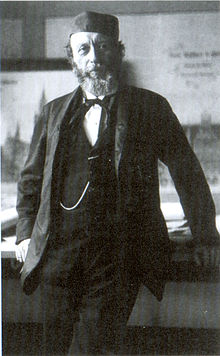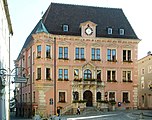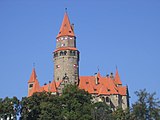Georg von Hauberrisser
Georg Joseph Hauberrisser , from 1901 Ritter von Hauberrisser , (born March 19, 1841 in Graz , † May 17, 1922 in Munich ) was a German-Austrian architect .
Life
His ancestors can be traced back to the 15th century in Assmannshausen in the Rheingau-Taunus district as aristocrats at that time. His father Georg Hauberrisser sen. (1781–1875) came from Erbach im Rheingau and was a master builder. His mother Juliane, née Röckenzaun (1815–1889), his father's third wife (marriage in 1838) and daughter of a master locksmith, came from the Styrian Mureck and is said to have had ancestors from Mecklenburg. Hauberrisser first studied technology at the Joanneum in Graz and became a member of Corps Joannea in 1861 .
In 1862 he moved to Munich to study architecture with Gottfried von Neureuther , Georg Friedrich Ziebland and Ludwig Lange . His teachers in Berlin were Johann Heinrich Strack and Karl Bötticher , and in Vienna , Friedrich von Schmidt , who influenced him in the neo-Gothic style.
Hauberrisser settled in Munich as an architect in 1866, where he built the neo-Gothic New Munich City Hall as his most important work from 1867 . Other important works are the New Town Hall of Kaufbeuren (1879–1881), the New Town Hall of Wiesbaden (1883–1887) and the town hall in the then still independent St. Johann , now Saarbrücken , (1897–1900). From 1887 to 1890 he built the Villa Holdereggen in Lindau on Lake Constance for the entrepreneur Hermann Näher . Sacred buildings by Hauberrisser are the neo-Gothic Herz-Jesu-Kirche in his hometown Graz (1881–1891) and the neo-Gothic Paulskirche in Munich (1892–1906). Also in historicizing forms he created for the Teutonic Order , the Bouzov Castle in Moravia to.
In 1893 Hauberrisser was accepted into the art department of the Maximilian Order for science and art . In 1901, Hauberrisser was awarded the Knight's Cross of the Order of Merit of the Bavarian Crown by Prince Regent Luitpold of Bavaria . Associated with this was the elevation to the personal nobility status and he was allowed to call himself Ritter von Hauberrisser after his entry in the nobility register . He was also holder of the Order of Merit of St. Michael II Class from 1910 .
Hauberrisser had six children with his wife Maria, née Wessely, whom he married on January 1, 1868: Georg (1869–1925), photo chemist, and Heinrich (1872–1945, architect in Regensburg); the third son Edwin (1882–1964) became professor of dentistry in Göttingen. Little is known about her three daughters.
The tomb of the family Hauberrisser is on the old southern cemetery in Munich (burial ground 21 - Series 1 - Number 7-8) Location .
His estate is very sparse: On the one hand, the house on Schwanthalerstrasse in Munich was badly damaged by the effects of the war, and on the other hand, the house of his son, Heinrich Hauberrisser, on Württembergstrasse in Regensburg was confiscated by US soldiers of the occupying forces. As a result, records and many estate items that the son kept in his villa were irretrievably lost.
Awards
- 1911: Dr. techn. hc from the Graz University of Technology
- Honorary member (1874) of the Munich Art Academy
- Royal Professor (1876) at the Munich Art Academy
- Golden Medal in Munich (1871)
- Medal of Honor at the World Exhibition of 1873 in Vienna
- Small gold medal at the Great Berlin Art Exhibition (1895)
- Order of the Iron Crown III. class
- Prussian Crown Order III. class
- Honorary Citizen of Munich (1919)
- Honorary citizen of Kaufbeuren
buildings
Kaufbeuren town hall
Saarbrücken town hall St. Johann
Neumatzen Castle (Lipperheide) in Münster (Tyrol)
Church tower of St. Jakob in Schwandorf
- 1881–1887: Herz-Jesu-Kirche in Graz, the construction management was carried out by architect Robert Mikovics
- In 1913 the St. Jakob church tower in Schwandorf was redesigned.
literature
- Georg Hauberrisser: The new town hall in Munich . Autotype-Verlag, Munich 1883.
- Oscar Doering : Two Munich architects. Gabriel von Seidl, Georg von Hauberrisser . General Association for Christian Art, Munich 1924.
- Hauberrisser Georg Joseph von. In: Austrian Biographical Lexicon 1815–1950 (ÖBL). Volume 2, Verlag der Österreichischen Akademie der Wissenschaften, Vienna 1959, p. 209.
- Hans Reuther : Hauberrißer, Georg Ritter von. In: New German Biography (NDB). Volume 8, Duncker & Humblot, Berlin 1969, ISBN 3-428-00189-3 , p. 70 f. ( Digitized version ).
- Egon Guggemoos: The Hauberrisser town hall in Kaufbeuren . Tourist office Kaufbeuren, Kaufbeuren 2004, ISBN 3-934509-46-0 .
- Jürgen Wurst: Georg von Hauberrisser (Hauberrißer). - p. 158 in: Jürgen Wurst and Alexander Langheiter (eds.): Monachia . Städtische Galerie im Lenbachhaus, Munich 2005, ISBN 3-88645-156-9 .
- Brigitte Huber: The New Town Hall in Munich. Georg von Hauberrisser (1841–1922) and his main work . Dölling and Galitz, Ebenhausen near Munich 2006, ISBN 3-937904-24-7 .
Web links
- Literature by and about Georg von Hauberrisser in the catalog of the German National Library
- Stories of great spirits: Arnold Zenetti (1824-1891 / City Planning Officer) Georg von Hauberrisser (1841-1922 / architect) and Alois von Erhardt (1831-1888 / Lord Mayor) discuss in the old southern cemetery. Online until May 4, 2022
Individual evidence
- ↑ Brigitte Huber: The New Town Hall in Munich, Georg von Hauberrisser (1841–1922) and his main work, Ebenhausen near Munich 2006, p. 194.
- ↑ Kösener Corpslisten 1960, 49 , 13.
- ^ From 1883 overhead line , in the Centralblatt der Bauverwaltung , No. 52, December 29, 1883, p. 486, accessed on December 22, 2012.
- ^ Bay. Statistisches Landesamt (Ed.): Court and State Manual of the Kingdom of Bavaria for 1914. Munich 1914, p. 29.
- ^ Brigitte Huber: The New Town Hall in Munich. P. 223.
| personal data | |
|---|---|
| SURNAME | Hauberrisser, Georg von |
| ALTERNATIVE NAMES | Hauberrisser, Georg Joseph Ritter von (full name); Hauberrisser, Georg; Hauberrisser, Georg Joseph |
| BRIEF DESCRIPTION | German-Austrian architect |
| DATE OF BIRTH | March 19, 1841 |
| PLACE OF BIRTH | Graz |
| DATE OF DEATH | May 17, 1922 |
| Place of death | Munich |













